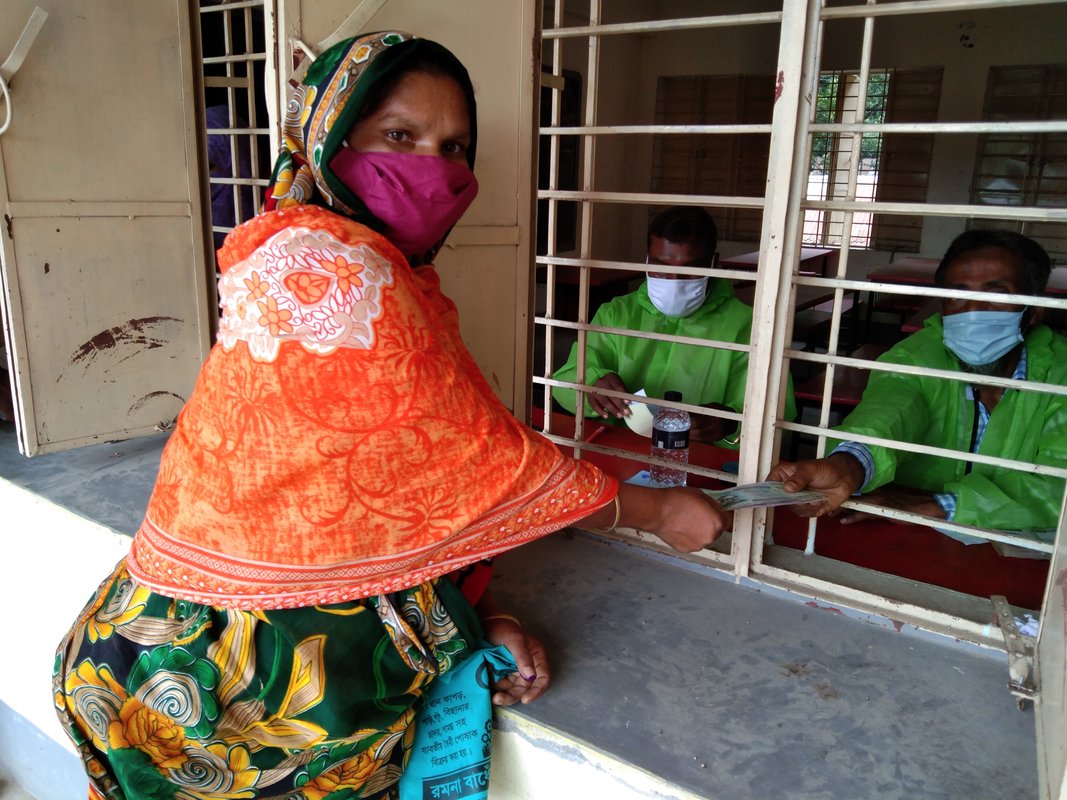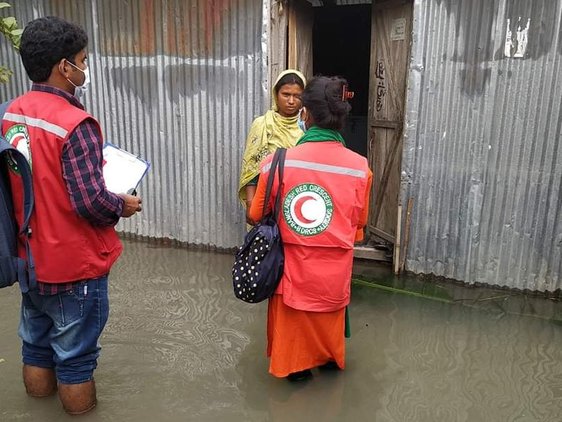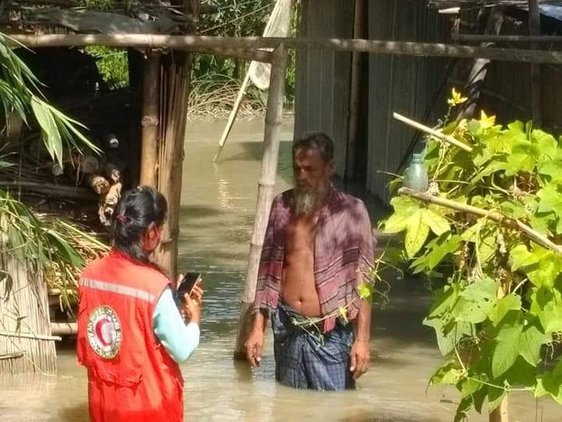The practitioners' guide to cash early action: experiences from Bangladesh
Since 2015, the Bangladesh Red Crescent Society, with technical support from the German Red Cross and the Red Cross Red Crescent Climate Centre, and funding from German Federal Foreign Office, has been implementing a forecast-based financing programme in Bangladesh. One of the early actions piloted for flood, cyclones and heat waves is unconditional, multipurpose cash transfers. Despite the challenges brought about by the COVID-19 pandemic, cash as an early action has proved to be successful in dealing with compound risks: the pandemic and extreme climate events.
The International Federation of Red Cross and Red Crescent Societies (IFRC) remains committed to the 'Grand Bargain', which includes pledges to increase funding to cash programming and localization. The Manila Call for Action (2018–22), made by the Asia-Pacific and Middle East/Gulf Red Cross Red Crescent National Societies, targets at least 60 per cent of National Societies in the region to be cash-ready and to scale-up to reach more people.
This blog shares experiences from the Bangladesh Red Crescent Society and German Red Cross around the benefits and lessons learnt around cash early action, to help inspire and guide other National Societies and beyond.

Why is cash early action important for beneficiaries?
Anticipatory action uses the window between a forecast and the actual event to support people to take early actions, in order to reduce the impact and losses of a disaster. Needs and preferences vary from one household to another, so it´s challenging for humanitarians to address them all. Providing cash is critical for giving people the freedom, dignity and choice to decide what they want to do. Cash is also quick and convenient to implement.
Recent studies in Bangladesh provide evidence on why cash early action is so important.
- An evaluation of the 2020 Early Action Protocol (EAP) for Floods found that recipients of a multi-purpose cash grant were able to care for and protect their cattle. Fewer multi-purpose cash grant recipients (9 per cent) reported a loss of cows and calves, compared to non-beneficiaries (22 per cent).
- The same study found that cash was effective in reducing negative coping strategies among beneficiaries. Fewer forecast-based financing beneficiaries (44 per cent), in comparison to non-beneficiaries (56 per cent), had to borrow money to deal with post-flood impacts. While 12 per cent of non-beneficiaries had to sell household assets, none of the beneficiaries needed to do so. In this way, the cash intervention contributed to household resilience.
- In 2021, heat wave early actions were tested in Dhaka and a post-distribution monitoring exercise found that most of the beneficiaries (86 per cent) who received cash preferred it to receiving food and other goods directly. However, others preferred to receive goods directly, due to a combination of reasons including: COVID-19 lockdown (14 per cent), the heat wave (12 per cent), price increases (9.5 per cent) and shortage of goods in the market due to the heat wave (5 per cent).
- In the same study, 55 per cent of beneficiaries reported that cash was effective in dealing with the negative impacts of heat waves and COVID-19, while the rest (45 per cent) found it an effective way to compensate losses due to the heat waves only.
For example, during the heat wave anticipatory action pilot in 2021, Ms Sharmin received a multipurpose cash grant of 4,500 Bangladeshi Taka (US$52); Ms Nasima received the same amount as part of the flood early action in 2020. This allowed them to take early actions to reduce the impact of the hazards.
The river erosion ... left me homeless. Now, I am displaced to this city. Hostile extreme heat and COVID-19 ... closed almost all avenues of our income. The cash grant was a great support to us – it was very timely, which saved my family from a state of extreme hardship and suffering.
There were floodwater and Corona (COVID-19) - the money [was] a great help to us during that challenging time. We bought one sack of rice and medicines for us. The rest of money we invested to buy a goat and two hens.
When is cash early action feasible?
- In the design phase, we need to understand if a cash transfer will really be effective in helping people to mitigate predicted impacts. For instance, can money reach people fast enough to take early action before a cyclone? Do they have time to spend the money? Would another action be more appropriate? Experiences have shown that we can effectively implement cash early action for floods and heat waves, but not for cyclones, as the lead time is too short for people to spend the money.
- Markets must be able to provide essential goods and services within a short lead time.
- The organization must be cash ready and have the capacity to deliver cash and voucher assistance within the short lead time. This must be assessed and ensured during the readiness phase.
- Financial service providers and other services must be able to mobilize their staff and systems quickly, flexibly and, in the best case, nationally. For instance, currently financial service providers must deliver contactless cash to reduce COVID-19 transmission, whereas previously cash was distributed physically via post offices. In addition, to comply with COVID-19 guidelines, financial service providers were working with reduced capacity, which caused some processing delays.
Can pre-registering households help?
Pre-registration of households - whereby a routinely updated database would be used to complete a rapid verification or validation process - could save a lot of time compared to the lengthier full registration process. Furthermore, this could reduce the risk of deploying volunteers nd staff while the water level is already rising during floods, or the temperature is high during heat waves.
Since the 2021 flood season, forecast-based financing actors in Bangladesh have been building a beneficiary database to be accessed and used during anticipatory actions. Previously, the Bangladesh Red Crescent Society utilized the lead time available after the pre-activation trigger, and drew on the strength of their volunteer pool, to quickly register beneficiaries just before implementing the early action. In future, improved social protection systems could provide a way to quickly pre-register vulnerable households.

Data collection in Gaibandha after activation of the EAP for Floods. (c) Bangladesh Red Crescent Society

Data collection in Gaibandha after activation of the EAP for Floods. (c) Bangladesh Red Crescent Society

Data collection in Gaibandha after activation of the EAP for Floods. (c) Bangladesh Red Crescent Society
Data collection in Gaibandha after activation of the EAP for Floods. (c) Bangladesh Red Crescent Society
How much cash should be transferred?
The multi-purpose cash grant for response and recovery was determined by the Bangladesh cash working group in 2018 as 4,500 Bangladeshi Taka (US$52) per person. A recent evaluation of the EAP for Floods activation in 2020 identified that 44 per cent of beneficiaries had to borrow money to manage the adverse impact of the flood. This raises the question of whether the grant amount should be increased to meet the needs of affected populations.
How does engagement with stakeholders make a difference?
The Bangladesh Red Crescent Society’s engagement with the community enabled them to quickly communicate key messages on alerts, and to take early actions such as evacuations or cash transfers. Engaging with the local administration and peoples’ representatives facilitated the smooth delivery of cash. Continuous engagement with financial service providers, and the revision of supporting agreements, enabled additional flexibility, understanding and support from them.
Are there any differences between rural and urban settings?
Experience in Bangladesh shows that there are differences in cash early action in rural and urban areas. For instance, while the modality of the cash transfer is through mobile money transfers, having an identity document is a prerequisite. While implementing cash transfer in Dhaka, it was found that many rickshaw drivers, van pullers and street vendors temporarily migrated, leaving their documents back in their village, which made it challenging to reach and serve them. These kinds of challenges were rare in rural communities. Appropriate, user-friendly technology will ease the transfers in both urban and rural contexts in the future, as the technology moves with the people.
As migrant and 'floating' populations in urban areas are more mobile, it was challenging to reach them for verification of information or to get post-distribution feedback. Rural households were more easily traceable, even after a couple of months.
In terms of utilization of the cash, a major portion was used for medical expenses and rent in urban areas, whereas expenditures in rural areas were more on food. Further research is needed on whether the cash grant amount in urban and rural settings needs to differ.
The way forward
Experiences in Bangladesh show that cash early action has the potential to benefit the lives and livelihoods of the most vulnerable people, to both flooding and heat waves. However, many insights were also gathered that need to be considered, including the constraints to processing and allocating cash in rural and urban areas, and the need for a collaborative, multistakeholder approach.
This blog was written by Sheikh Khairul Rahaman, German Red Cross Bangladesh. For further information on cash early action, please contact Anita Auerbach.
